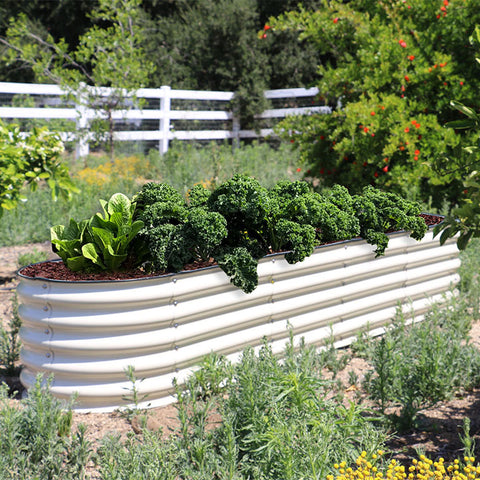Tips from Olle Garden Bed:10 Common Flowering Plants Toxic To Pets
We love our furry and feathered children (or some call them pets). We will make every effort to make them safe, happy and healthy.But sometimes, especially when it comes to gardeners, our homes are full of things that might hurt them. We may not even realize this. The following content also has some reference value for raised garden beds.
Whether it's indoor plants, beautiful bouquets for anniversaries, or your flowering garden bed, some flowering plants may pose a threat to your pet. Cats, dogs and even birds tend to nibble on things they should not.

If you have a curious pet, you'd better avoid these ten flowering plants.
- Amaryllis
Amaryllis is a favorite of flowering houseplants. With its striking lilies and interesting leaves, amaryllis lights up any room in winter.
Unfortunately, this amazing flower is also toxic to your pet. In fact, it is poisonous to all animals. Bulbs, leaves and stems contain phenanthridine alkaloids, which can cause adverse reactions to pets.
If your pet ingests any part of amaryllis, they may vomit or salivate excessively. Large amounts can cause diarrhea and tremors. Other symptoms include stomach pain and decreased blood pressure.
Do not put them around pet rabbits or gerbils, as their effects are particularly harmful. Moreover, if you have a stray cat or dog, please keep Amalis away from your home and garden.
- Narcissus
Narcissus is another amazing plant that is common in families and gardens. Your pet rabbit can chew it happily and be fine. But your bird, cat or dog may be in danger.
Narcissus contains lycorine, an alkaloid. Other toxins such as glycosides are also present in daffodils. These toxins are present in all parts of the plant and are concentrated in the bulb. This may be bad news for dogs who dig garden beds.
Pet narcissus poisoning can cause severe diarrhea, tremor, drooling and vomiting. Cats and birds sometimes have seizures. If birds eat too much, depending on the type and size of your feather friends, it may lead to death. Cats also experience arrhythmias and breathing difficulties. Under mild conditions, dogs may experience "narcissus itching", which is caused by the reaction caused by contact with plant juice.
Dogs usually recover within a few days. However, if you think they have chewed anything they should not eat, always monitor for symptoms.
- Lily
Lily always stands out in the bouquet or as an independent feature in the garden. However, although they are amazing, unfortunately, they need to stay away from pets.
All lilies have adverse effects on pets, especially birds and cats. All parts of plants, including pollen, and even the water in the vase, are poisonous to animals.
The effect may vary depending on the type of lily ingested.
All lily flowers will stimulate the oral cavity and digestive tract of cats, dogs and birds, and should be far away from your home. You will know if your furry friends have ever chewed lilies, if their lips are swollen and they have paws on their paws. They may also have nausea and vomiting.
Some lily types are much more dangerous. Easter Lily and Tiger Lily should be avoided at all costs, especially for cat owners. Exposure to any part of these plants can cause sudden kidney failure in cats.
- Morning Glory
Morning glory is often the first vine challenge that gardeners try, second only to ivy (by the way, ivy is also toxic to pets). They grow because of their bright colors and attract hummingbirds and butterflies, making them a perfect complement to the garden.
Unfortunately, they are not suitable for cats, dogs and birds. This plant contains chemicals called ergot alkaloids. These can cause vomiting, tremor, dilated pupils, and even liver failure in pets. Horses should also avoid morning glory.
The ergot alkaloids are similar to the chemicals found in LSD, and they are most concentrated in the seeds of morning glory. If your birds, even cats or dogs, chew these seeds, they may have hallucinations, leading to confusion and lethargy.
Although they are amazing, it is best to avoid the morning glory in the garden.
- poinsettia
Magenta is one of the best holiday season plants. Its dark red hybrid flowers and dark green leaves are mixed together, which really brings the joy of the festival. Although they are not as poisonous as other plants, poinsettia still causes slight irritation to some pets.
Cats and dogs may experience mild vomiting and drooling after ingesting plant juice. This milky juice contains chemicals, diterpenoid Euphorbia esters, which can cause these adverse effects. If your cat or dog gets this juice on its skin, it may become inflamed and itchy. Serious poinsettia poisoning is rare in cats and dogs, but birds are more seriously affected.
Some people claim that the toxicity of poinsettia has been exaggerated. Fortunately, the impact on some pets is only slight. But it's still a good idea to keep your pet away from this decorative holiday plant - just in case.

- Azalea
The azalea or any member of the azalea family is poisonous to pets. Disappointing, I know, because they are the scene of flowering season. The bitter taste of plants usually prevents pets from chewing too much, and the impact on some pets is only slight. However, if you have horses or any other livestock on your property, azaleas can cause trouble.
All parts of plants are poisonous and contain toxins called gray toxins. These toxins are toxic not only to animals, but also to humans.
The symptoms of rhododendron poisoning in cats and dogs are similar to those mentioned above: excessive drooling, vomiting and diarrhea. If they had not been bothered by the bitter taste of azaleas, their symptoms might have been worse. Pay attention to tremors, seizures and anorexia.
On the other hand, livestock, especially horses, will experience more dangerous symptoms and side effects. Grey toxins can cause cardiac arrest, anorexia and seizures in horses. Symptoms can occur within a few minutes. You may notice foam like saliva and muscle weakness in the horse's mouth.
In terms of animals, azalea is undoubtedly one of the forbidden plants.
- Chrysanthemum
Another disappointing flowering scene on this list is chrysanthemums. These plants are poisonous to cats, dogs, rabbits and many other animals.
The leaves and stems contain pyrethroids. If ingested, it will cause vomiting, diarrhea, drooling, and sometimes loss of appetite.
Interestingly, pyrethroids are a common ingredient in dogs and other insecticides to treat ticks and fleas. Before using pest deterrent sprays, be sure to carefully check their ingredients, especially indoors, to ensure that they will not cause any accidental harm.
- Hydrangea
Hydrangea is one of the most common garden plants and cut flowers in the family. A variety of bright colors add vitality to any space indoors and outdoors. Unfortunately, although we love them, they should not be near curious pets.
Hydrangea is not highly toxic to some pets (such as cats and dogs), but if smaller pets eat this plant, they may be seriously ill. Hydrangea contains cyanide glycosides, which can cause vomiting, diarrhea and breathing difficulties in some pets.
Cats may become depressed, have seizures and become stiff. On the other hand, dogs may lose appetite, fatigue, and even fever.
Smaller mammals and pets, such as birds and rabbits, may have similar symptoms, but their size is a matter of concern. Even a small amount of hydrangea may cause serious symptoms in your pet.
Unlike lily, you can still plant hydrangea in your garden or at home. But make sure your pet doesn't eat leaves, stems or flowers.
- Tulip
Although technically part of the lily family, the popularity of tulips and their potential danger to your pets place them on this list.
Tulip is one of the most dangerous flowers for pets. No matter the size of tulips or the number of legs of animals, tulips are highly toxic. Tulip contains toxic lactones and alkaloids, concentrated in the bulb. If your pet eats any part of the plant, especially flowers, they will have various symptoms, including diarrhea, nausea, vomiting and excessive drooling.
Dogs may have seizures, tremors, dizziness, and even death. Tulip poisoning can also cause the death of birds, rabbits and other small pets.
Marco can have different symptoms, including colic, increased heart rate, and even jaundice.
Although sad, you may want to avoid planting tulips in your garden. They may look beautiful in the vase, but for safety reasons, please skip them when you go to the flower shop.

- Tagetes erecta
Marigold is a favorite companion plant for many gardeners. Bright yellow and orange attract bees and other helpful insects to your garden. But they can have a negative impact on some pets.
If cats chew leaves, they may have stomachache and mouth inflammation. They also have drooling and diarrhea. Marigold juice also irritates cat skin.
Marigold is safer around dogs, but the juice can also irritate their skin, especially if you have a dog with sensitive skin.
In addition to possible skin irritation, marigold is generally considered safe for most pets. However, if you have cats, it is best to keep them away from your marigold bushes.
It's always good to know which plants will do harm to our furry feathered family members. Some flowering plants are not as poisonous as others, but it is better to be safe than sorry. If you suspect that your pet has ingested harmful plants or substances, please consult a doctor immediately.
